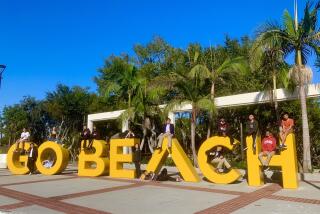Campus Repair Cost Detailed
- Share via
Earthquake repair costs at Cal State Northridge included $41 million for consultants, lawyers and accountants and $43.2 million on temporary classrooms, security and equipment replacement, according to partial spending breakdown released this week.
The consultants’ share amounts to 14.5% of the $283.7 million that federal and state governments approved--as of March 31--to repair university facilities heavily damaged in the Jan. 17, 1994, Northridge earthquake. The $43.2 million for trailer rentals, security and equipment represents 16% of that total. The rest of the money has gone or will go to actual construction, the university said.
Industry experts said the large expenditures on non-construction items is not out of line considering the complex nature of earthquake repairs.
Bud Griffis, a professor of construction at Columbia University’s civil engineering department, said there are no industry standards for consultants’ fees.
“It’s whatever the market will bear. Consultants in California are expensive. I don’t think it [$41-million payment] is out of line at all,” Griffis said in an interview. Industry representatives agreed. Elwood Smietana, senior vice president of the Irvine-based EQE International, and Chris Poland, a structural engineer and president of the San Francisco-based Degenkolb Engineers, said consultants’ fees vary from project to project.
Smietana said a rough rule of thumb for a consultant’s fee is 8% to 10% of the actual construction cost, but that this does not apply to “seismic retrofitting. That is a very, very specialized area.”
Meanwhile, Bruce Erickson, a CSUN spokesman, said there are several checks and balances within the system to ensure repair spending is proper and aboveboard. For instance, he said, the Cal State University system, the Federal Emergency Management Agency, which contributes 90% of the earthquake repair costs, and the Governor’s Office of Emergency Services (OES), which picks up the rest, all have their own auditors to scrutinize the spending.
Erickson said it would not have been practical or wise to wait for bids when people’s lives were at stake, especially during the first few weeks after the earthquake.
Dave Duffer, FEMA’s chief of public assistance, and David Fukutomi, the OES projects and operations manager, said they were satisfied with CSUN’s earthquake-repair spending. But they reserved final judgment until they see all bills after the completion of the projects that are not expected before December 1999.
Said CSUN’s Erickson: “I would suspect [the consultants’ payment] is somewhat unusual, but our circumstances were unusual: No other university campus ever experienced such damage from a single natural disaster.”
John Chandler, another CSUN spokesman, said the consultants are hired to perform a number of jobs, from estimating structural damages to conducting feasibility, planning and design studies. He said consultants are still at work estimating damages to some of the 25 major buildings on the campus.
FEMA recently approved another $37.5 million for CSUN’s earthquake repairs, making the total $321 million. According to CSUN figures as of March 31, the university received $244.6 million and had spent $187.5 million.
Erickson said the consultants’ final tab could be higher since the university has yet to launch several construction activities that include the two Delmar T. Oviatt Library wings, a new $14.3-million fine arts building, a $10.7-million administration tower, a technology center that will house the $7-million College of Health and Human Development and a $7-million computer center.
(BEGIN TEXT OF INFOBOX / INFOGRAPHIC)
CSUN Quake Repair
FEMA has approved $284 million for quake repair at CSUN. The university has received $245 million of that and spent $187 million. CSUN estimates that total repair costs will run $321 million. Here’s how the money has been spent so far:
Temporary facilities: 12%
Consulting: 14%
Construction: 70%
Other costs: 4%
* Includes temporary facilities, security and shuttle service.
Source: Cal State Northridge
More to Read
Sign up for Essential California
The most important California stories and recommendations in your inbox every morning.
You may occasionally receive promotional content from the Los Angeles Times.













